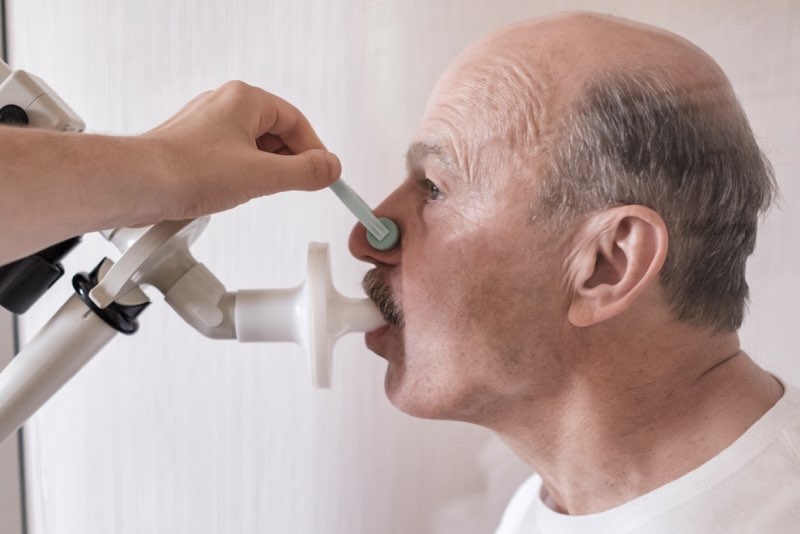A new study that monitors the number of emergency room visits for asthma pollen-induced outbreaks in Central Texas metropolitan areas underscore the importance of knowing local plants and the need to develop science-based pollen forecasts.
Asthma caused by pollen
Such predictions could one day alert vulnerable people to days when they should consider staying home or taking allergy medications early, since some treatments may take hours or days to take full effect.
“Although the percentage of asthma emergency room visits associated with pollen overall was only a small percentage on an annual basis, during certain times of the year when particular types of pollen were on the rise, we sometimes saw up to nearly 20 percent of visits due to pollen,” said Daniel Katz, associate professor in the School of Integrative Plant Science, Soil and Crop Section, in the College of Agriculture and Life Sciences.
For every emergency room visit, there are many more unreported allergic reactions that lead to a reduction in quality of life. “This is just the tip of the iceberg,” Katz said.
Katz is the first author of ” Pollen and Viruses Contribute to Spatio-temporal Variation in Asthma-related Emergency Department Visits “, published in the July issue of the journal Environmental Research.

In the study, researchers identified which asthma emergencies might have been triggered by pollen, rather than a virus or other causes. To do so, researchers collected data from the Texas Department of State Health Services and analyzed nearly 175,000 asthma-related emergency room visits between 2015 and 2020. They identified visits by patients who lived within about 15 miles (25 kilometers) of one of eight pollen monitoring stations that measure pollen concentrations in the air.
Pollen count data and viral prevalence information were collected during the same years in College Station, Dallas, Flower Mound, Georgetown, near Austin, Houston, two locations in San Antonio, and Waco.
“One of the most difficult aspects of this topic is that when a patient has an asthma exacerbation, it’s difficult to know what caused it,” Katz said.
By comparing these daily emergency room visits with daily pollen counts, Katz and colleagues were able to see whether more people ended up in the hospital for asthma on days when pollen counts were high or had been high in the previous week, to account for delays and late reactions.
Similar correlations were made with weekly viral load data, although due to fewer data points they looked at three-week moving averages to identify underlying patterns. The links between severe asthma attacks and viruses have been well studied.

When pollen and virus prevalence were high at the same time, researchers had the advantage of having plenty of data, from eight cities over five years, to uncover the likely causes.
“Sometimes the timing of when viruses were prevalent changed,” Katz said, “and sometimes the timing of when pollen was in the air changed. So because of that natural variability, we were able to better tease out what was contributing to these asthma-related emergency room visits.”
The study also covered 2020, when COVID caution reduced many viruses to historically low levels, providing further clues about the effects of airborne pollen, Katz said.
The researchers chose the cities for the study based on their proximity to central Texas, where a tree species, the Ashe juniper (Juniperus ashei), one of the most important producers of allergenic pollen, is prevalent. Some cities were in the middle of these pollen hot spots, and others were far from them.

“We ended up finding that some cities had these spikes in asthma-related emergency room visits in January, when that species releases its pollen, while cities outside its primary range didn’t have corresponding spikes,” Katz said. However, he said, various pollens are in the air for much of the year in Texas, creating challenges for people with asthma.
The study helps guide Katz’s ongoing work to develop publicly accessible pollen forecasts that integrate remote sensing, atmospheric dispersion, and plant ecology.
Authors include Corwin Zigler, Darlene Bhavnani, Susan Balcer-Whaley, and Elizabeth Matsui of the University of Texas, Austin.
Climate Change May Increase Emergency Room Visits for Allergic Asthma
If greenhouse gas emissions continue to increase and cause longer oak pollen seasons, more children could end up in emergency rooms due to allergy-induced asthma.
The research found that if greenhouse gas emissions continue to rise through the end of this century, oak pollen season in some areas could be extended by up to eight days. People with oak pollen allergies, especially children, will be more exposed to pollen that can induce allergic asthma. This could increase hospital emergency room visits associated with allergic asthma by 10 percent in the Midwest, Southeast and Northeast combined, the new study found.
According to the study authors, allergic asthma associated with oak pollen brings more than 20,000 people to the emergency room each year, and the increase in pollen could lead to a 10 percent increase in emergency room visits by 2090.
According to the new study published in GeoHealth, a publication of the American Geophysical Union, these additional emergency room visits would add an estimated $10.4 million to the projected $346.2 million in baseline costs through 2090.
“We found that the severe climate change scenario had a substantial impact on public health,” said Susan Anenberg, an environmental scientist at Environmental Health Analytics, LLC, in Washington, D.C., and lead author.

The study is part of a growing body of research on the health impacts of climate change and the economic burden on individuals. Previous research has shown that rising atmospheric carbon dioxide has caused ragweed, another strong allergen, to produce higher pollen concentrations, according to the study authors.
The new study could help doctors anticipate changes in allergic asthma due to climate change, said Samantha Ahdoot, a pediatrician in Alexandria, Va., and associate professor of pediatrics at Virginia Commonwealth University School of Medicine, who was not involved in the study.
“I hope this research will help the public and policy makers understand that changes in the environment, whether it’s plant life or climate, have negative impacts on people’s health,” he said.
In the new study, Anenberg and colleagues calculated the number of emergency room visits for allergic asthma in the Southeast, Midwest, and Northeast, today and in the future, using observed relationships between oak pollen and emergency room visits for asthma in Atlanta, Cincinnati, and New York City.
They found that there were 21,200 emergency room visits for oak pollen-related allergic asthma in 2010. Of those visits, 70 percent were for children under the age of 18, indicating that children may be more vulnerable to climate change-related health impacts, according to Anenberg.

The study authors used climate models and known relationships between temperature, precipitation, and oak pollen to estimate the length of the oak pollen season under both a moderate and a severe climate change scenario.
Combining information on emergency department visits and the climate model, the study authors found that the most severe climate change scenario would increase emergency department visits in the three regions by 5 percent in 2050 and 10 percent in 2090. In a moderate climate change scenario, the number of visits would increase by only 4 percent, averting more than half of the emergency incidents in the severe scenario, the study found.
“The impact of oak pollen on human health in the United States is extensive and will likely worsen over time with climate change,” Anenberg said. “Our results may underestimate a much larger problem, as environmental changes could also affect other types of pollen and other health outcomes.”
#Asthma #Emergencies #Increase #Allergenic #Pollen #Blooms